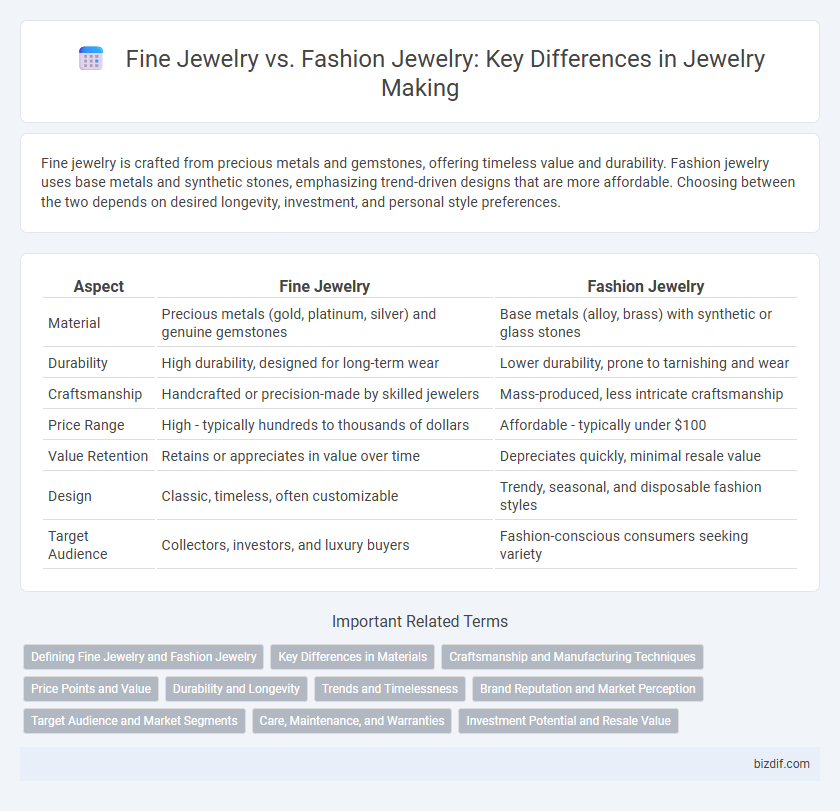Fine jewelry is crafted from precious metals and gemstones, offering timeless value and durability. Fashion jewelry uses base metals and synthetic stones, emphasizing trend-driven designs that are more affordable. Choosing between the two depends on desired longevity, investment, and personal style preferences.
Table of Comparison
| Aspect | Fine Jewelry | Fashion Jewelry |
|---|---|---|
| Material | Precious metals (gold, platinum, silver) and genuine gemstones | Base metals (alloy, brass) with synthetic or glass stones |
| Durability | High durability, designed for long-term wear | Lower durability, prone to tarnishing and wear |
| Craftsmanship | Handcrafted or precision-made by skilled jewelers | Mass-produced, less intricate craftsmanship |
| Price Range | High - typically hundreds to thousands of dollars | Affordable - typically under $100 |
| Value Retention | Retains or appreciates in value over time | Depreciates quickly, minimal resale value |
| Design | Classic, timeless, often customizable | Trendy, seasonal, and disposable fashion styles |
| Target Audience | Collectors, investors, and luxury buyers | Fashion-conscious consumers seeking variety |
Defining Fine Jewelry and Fashion Jewelry
Fine jewelry is crafted from precious metals such as gold, platinum, and silver, often featuring genuine gemstones like diamonds, emeralds, and sapphires, emphasizing durability and investment value. Fashion jewelry, also known as costume jewelry, is made from base metals and synthetic materials, designed primarily for aesthetic appeal and trend-driven styles at an affordable price point. The distinction lies in the quality of materials, craftsmanship, and intended longevity, with fine jewelry often considered a long-term asset while fashion jewelry serves seasonal or casual wear purposes.
Key Differences in Materials
Fine jewelry is crafted from precious metals like gold, platinum, and sterling silver, often adorned with genuine gemstones such as diamonds, sapphires, and emeralds. Fashion jewelry, also known as costume jewelry, typically uses base metals like brass or copper and features synthetic or imitation stones like cubic zirconia or glass crystals. The durability, value, and craftsmanship quality significantly differ due to these material choices, influencing both price and longevity.
Craftsmanship and Manufacturing Techniques
Fine jewelry is crafted using precious metals like gold and platinum, often featuring hand-finished techniques that ensure durability and intricate detailing. Fashion jewelry utilizes base metals and synthetic materials, produced through mass manufacturing processes such as stamping and casting to achieve cost-effective designs. The craftsmanship in fine jewelry emphasizes artisanal skills and long-lasting quality, whereas fashion jewelry prioritizes trend-driven aesthetics and rapid production.
Price Points and Value
Fine jewelry is crafted from precious metals like gold and platinum, often set with genuine gemstones, resulting in higher price points due to material quality and craftsmanship. Fashion jewelry uses base metals and synthetic stones, offering more affordable options but generally lower long-term value and durability. The investment in fine jewelry tends to appreciate or maintain value, while fashion jewelry is primarily favored for trend-driven, short-term wear.
Durability and Longevity
Fine jewelry, crafted from precious metals like gold or platinum and often set with genuine gemstones, offers superior durability and longevity due to its high-quality materials and meticulous craftsmanship. Fashion jewelry, typically made from base metals and synthetic stones, tends to wear out more quickly, with increased susceptibility to tarnishing, discoloration, and breakage over time. Choosing fine jewelry ensures lasting beauty and structural integrity, making it a valuable investment for enduring style.
Trends and Timelessness
Fine jewelry, crafted from precious metals and gemstones, epitomizes timeless elegance and enduring value, often favored for investment and heirloom pieces. Fashion jewelry embraces bold, trend-driven designs using materials like base metals and synthetic stones, catering to seasonal styles and affordability. While fashion jewelry allows frequent updates to keep pace with evolving trends, fine jewelry remains a lasting symbol of sophistication across generations.
Brand Reputation and Market Perception
Brand reputation significantly influences consumer trust and perceived value in fine jewelry, where established names like Cartier and Tiffany & Co. dominate due to their legacy of craftsmanship and exclusivity. Fashion jewelry brands such as Swarovski and Pandora emphasize trendiness and affordability, shaping market perception around accessibility rather than long-term investment. Market perception of fine jewelry centers on durability, precious materials, and prestige, while fashion jewelry is viewed as a versatile, stylish option for everyday wear.
Target Audience and Market Segments
Fine jewelry targets affluent consumers seeking high-quality materials like gold, platinum, and precious gemstones, appealing to luxury market segments valuing exclusivity and investment. Fashion jewelry attracts trend-conscious, budget-friendly buyers who prioritize style and versatility, often tapping into fast-changing youth and mass-market demographics. Both segments utilize distinct marketing strategies tailored to consumer preferences and purchasing motivations within the jewelry industry.
Care, Maintenance, and Warranties
Fine jewelry, crafted from precious metals and gemstones, requires regular professional cleaning and careful storage to maintain its luster and value, with many pieces backed by robust warranties covering repairs and defects. Fashion jewelry, often made from base metals and synthetic materials, demands gentler cleaning methods to prevent tarnishing and typically offers limited or no warranty coverage. Proper maintenance tailored to each jewelry type ensures longevity and preserves aesthetic appeal over time.
Investment Potential and Resale Value
Fine jewelry, crafted from precious metals and gemstones such as gold, platinum, diamonds, and sapphires, holds significant investment potential due to its intrinsic material value and craftsmanship. Fashion jewelry, often made from base metals and synthetic stones, offers limited resale value as it lacks enduring worth and tends to follow seasonal trends. Collectors and investors prioritize fine jewelry for its ability to appreciate over time and retain market value in the secondary market.
Fine jewelry vs Fashion jewelry Infographic

 bizdif.com
bizdif.com